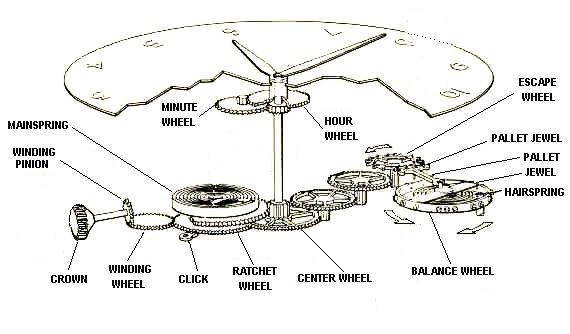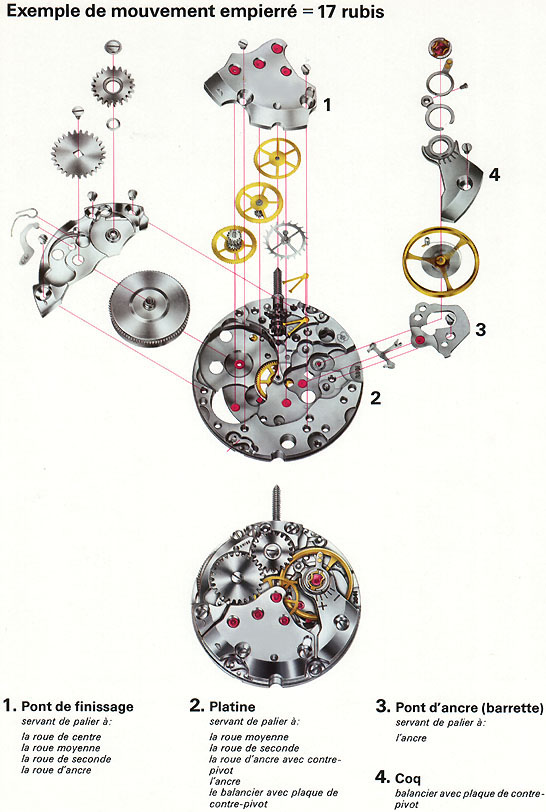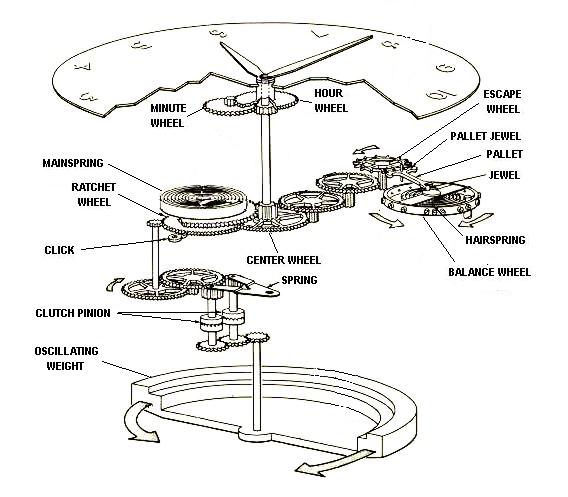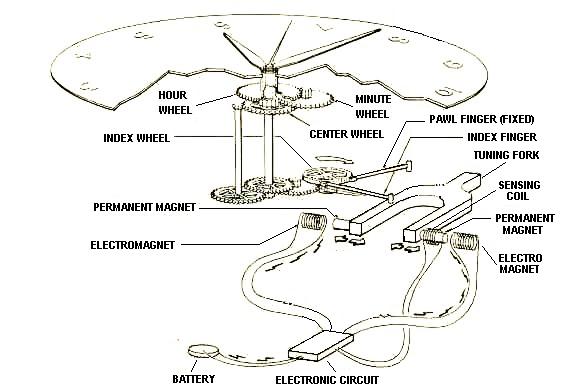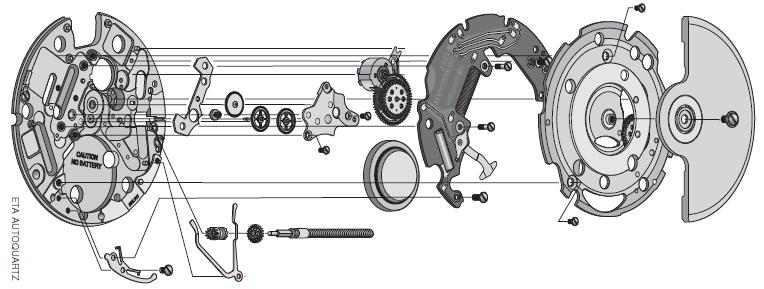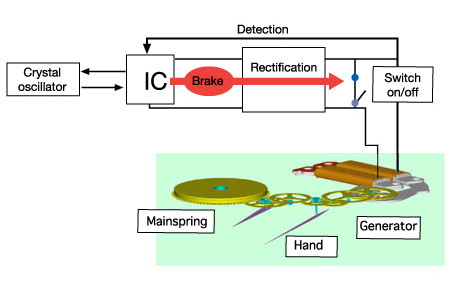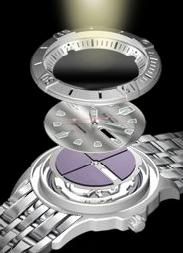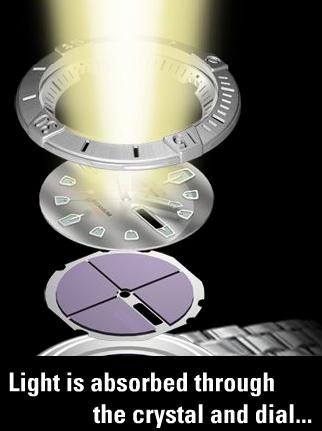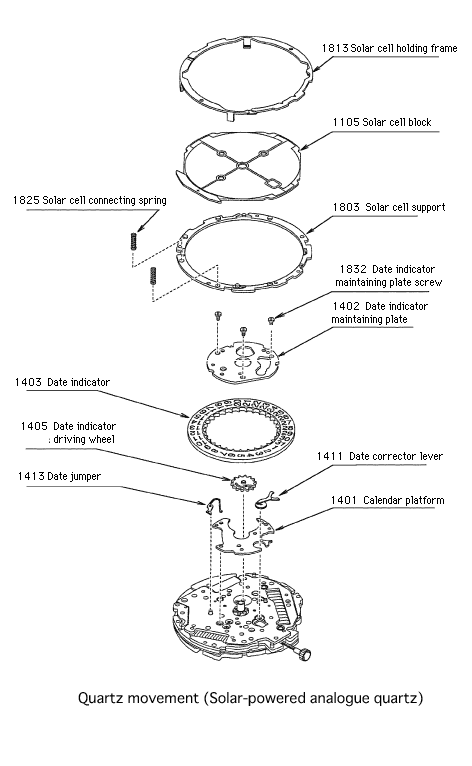



| Strukturák | Fejlödéstörténet | Rajzok |
| Structures | History of development | Drawings |
Vessünk egy pillantást az eddig kifejlesztett óraszerkezetekre.
A struktúrák fejlödésének áttekintését színkódolással próbáltam segíteni. |
Let's take a look at the wristwatch calibre types developed so far.
I used color codes to ease the overview of development of structures. |
| Mechanikus | Elektro-mechanikus | Elektromos | Elektro-mágneses |
 |
 |
 |
 |
| Mechanical | Electro-mechanical | Electronic | Electro-magnetic |
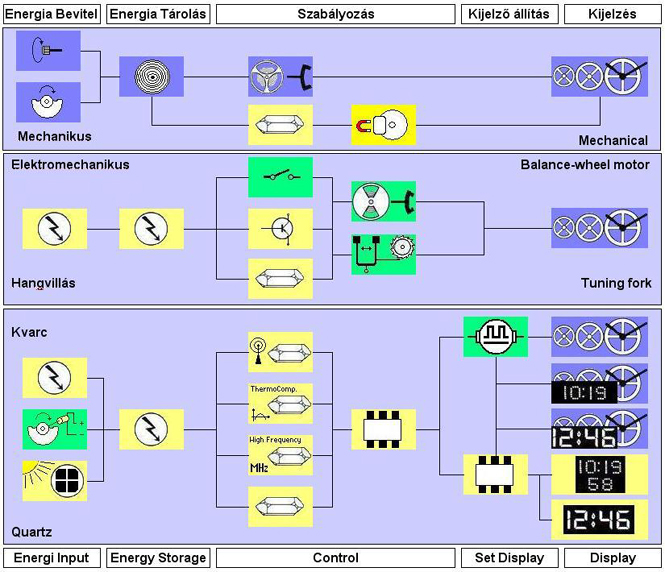
|
A lehetséges megoldások vátozatok száma igen nagy. Az összes lehetséges megoldást ezen a linken mutatom be: Az alábbi táblázat tartalmazza az általam ismert létezö megoldásokat.
|
The theoretically possible solutions are numerous. I show all theoretically possible solutions at the link: The table below shows the existing solutions I know.
|
| Energia Bevitel | Energia Tárolás | Szabályozás | Szabályozás | Kijelzö állítás | Kijelzés | ||
Kézi húzású |
|
|
|
|
|
|
|
Automata |
|
|
|
|
|
|
|
Spring Drive |
|
|
|
|
|
|
|
Spring Drive |
|
|
|
|
|
|
|
Billegömotoros |
|
|
|
|
|
|
|
|
|
|
|
|
|
|
|
|
|
|
|
|
|
|
|
Hangvillás |
|
|
|
|
|
|
|
|
|
|
|
|
|
|
|
Kvarc |
|
|
|
|
|
|
|
|
|
|
|
|
|
|
|
|
|
|
|
|
|
|
|
|
|
|
|
|
|
|
|
|
|
|
|
|
|
|
|
Magas frekv. |
|
|
|
|
|
|
|
Hökompenzált |
|
|
|
|
|
|
|
|
|
|
|
|
|
|
|
Rádiós |
|
|
|
|
|
|
|
|
|
|
|
|
|
|
|
|
|
|
|
|
|
|
|
Kinetic |
|
|
|
|
|
|
|
|
|
|
|
|
|
|
|
Solar |
|
|
|
|
|
|
|
|
|
|
|
|
|
|
|
|
|
|
|
|
|
|
|
Solar Rádiós |
|
|
|
|
|
|
|
|
|
|
|
|
|
|
|
|
|
|
|
|
|
|
|
| Energy Input | Energy Storage | Control | Control | Setting Display | Display |
|
Nézzük meg a fent leírt megoldások kialakulásának idörendjét. |
Let's see the history of developmentof the above described solutions. |
1650 |
Állítólag 1650-ben a francia filozófus Blaise Pascal csuklójára kötötte zsebóráját. Attól a pillanattól számíthatjuk a karóra korszakát. Az alkatrészek, szerelvények, anyagok természetesen hatalmasat fejlödtek, de a müködési elv ma is ugyanaz: rúgós billegövel periódikusan megakasztani a rúgó letekeredését, ami a mutatókat mozgatja. Eredetileg a motor-rúgót kézzel kellett felhúzni. Reportedly French Philosopher Blaise Pascal in 1650 fitted his pocket watch to his wrist. From that point we can count the era of wristwatch. Parts, assemblies, materials used for the mechanical watch were obviously developed to a great deal but the principle is the same: periodically stop the unwinding of mainspring what moves the hands using spring-driven balance. Originally the mainspring was manually wound. |
|
1929 |
Noha A.L. Perrelet az 1770-es években feltalálta az automatikus felhúzást, annak kevés haszna volt a zsebórákban. 1929-ben a harwood cég karórában is megvalósította az elvet. Lengö súly valamilyen mechanizmuson keresztül felhúzza a motor-rúgót, megszabadítva a tulajdonost a kézi húzástól. Ellenben csak a járástartalékkijelzöröl -ha van ilyen az órán - tudható biztosan, hogy mennyi ideig lesz még elegendö a hajtóenergia. Although A.L. Perrelet in 1770s has invented the automatic rewinding, it was not very useful in pocket watches. In 1929 company Harwood managed to fit the principle to wristwatch. Oscillating weight through some mechanism rewinds the main spring freeing the owner from manual winding but you can only know how long the energy would be enough looking at power reserve indicator if your automatic watch is equipped whit that. |
|
1957 |
Az elektromosságot a XX. század elejétöl használták idömérésre, de csak 1957-ben készítette el a Hamilton cég az elsö billegömotoros karórát. Ez egy forradalom kezdete volt. Noha a mechanikus kapcsolású elektromos órák nem voltak sem nagyon megbízhatóak, söt, járáseltérésük is nagy, mint a mechanikusok, bebizonyították, hogy lehetséges elektromos karórát készíteni. Electricity was used for time keeping since the beginning of 20th century, but only in 1957 could Hamilton produce the first electric balance-wheel wristwatch. That was the start of a revolution. Although the mechanically switched electrical watches were unreliable and not more accurate than the mechanicals, they have proven that electrical wristwatch is feasible. |
|
1959 |
A következö lépés a félvezetök alkalmazása a kapcsolásban. Tranzisztorok, majd integrált áramkörök váltották fel a mechanikus kapcsolást. Az elektromos órából elektronikus lett. Itt, a már megbízható elemes óráknál kell megjegyeznünk, hogy a járástartalák ugyan napokról hónapokra, késöbb évekre nött, de csak évtizedek múltán jelentek meg az elem fogyását jelzö megoldások. The next step was to use solid-state semiconductors in switching. Transistors then integrated circuits replaced the mechanical switching. The electric watch became electronic. At this point when the battery-driven watches became reliable we have to note that despite the power reserve was increased to months later to years, it took some decades to have the first watches indicating the end of battery-life. |
|
1960 |
Majdnem egy évszázaddal azután, hogy Louis Breguet, a nagy Abraham-LouisBreguet unokája szabadalmaztatta a hangvillás óra elvét, Max Hetzel tervei alapján a Bulova piacra dobta a hangvillás karórát. A két nagyságrenddel magasabb frekvencia nagy fejlödést hozott az óra járáseltérésében, fütyülö hangja pedig lenyügözte a tulajdonosokat. Almost a century after Louis Breguet grandson of the great Abraham-LouisBreguet had patented principle of tuning fork watch, upon the design of Max Hetzel of Bulova introduced tuning fork wristwatch. The two orders of magnitude higher frequency resulted in a leap in accuracy and the whistling sound amazed the owners. |
|
1969 |
Az 1960-as évek végén Japán és Svájc hatalmas versenyt futottak, hogy ki tud elöbb piacra lépni kvarc karórával. A gyöztes Seiko Atron nincs birtokomban, ezért a második CEH Beta 21 képe látható itt. At the end of 1960s Japan and Switzerland were competing who will be first on the market with quartz wristwatch. I do not have Seiko Astron which won, so I put here the picture of the second one CEH Beta 21. |
|
19?? |
Nagy ötlet kvarc oszcillátor felhasznlásával csökkenteni a az elektro-mechanikus órák járáseltérését. Ez a remek ötlet, felhasználni a meglévö gyártó kapacitásokat, de mégis javítani a járáseltérést, még elökerül az óragyártás történetében. Great idea was to use quartz oscillator to improve accuracy of electro-mechanical watches. That brilliant idea of profiting from existing manufacturing capabilities, but improving accuracy a lot will return later in history of watch-making. |
|
1973 |
A hangvillás órák zászlóvivöje a Bulova érzékelve a kvarcóra kihívását, kvarc vezérléssel javította tovább a hangvillások járáseltérését. Bulova the champion of tuning fork watches realizing the challenge of quartz watch tried to improve the deviation of tuning fork with quartz control. |
|
1974 |
Kvarc forradalom második mérföldköve az LED kijelzös óra. Már a hagyományos mutatószerkezetre sincs szükség. Ezután már csak a nyomógombok maradtak mechanikai elemek az órában, tovább nött megbízhatóságuk. The second milestone of quartz revolution was LED display. There was o need anymore for classical gear train and hands. Only the push buttons remained mechanical in the watch increasing their reliability. |
|
1976 |
A LED magas áramfogyastása miatt tovább folyt a kutatás, ami a kis fogyasztású LCD kijelzök alkalmazásához vezetett. High power consumption of the LED the research went on and resulted in using the low consumption LCD displays. |
|
1988 |
Az elemek problémáját elkerülendö a Seiko kidolgozta az automata szerkezettel meghajtott generátorral táplált órát. Az AGS az automata generáló rendszer lett a máig sikeres Kinetic órák öse. To overcome the problem of battery Seiko developed the watch based on generator driven by automatic mechanism. AGS Automatic Generating System became the root of the currently successful Kinetic family. |
|
1990 |
Az alacsony járáseltérés elérésének végsö lépése a rádió-vezérelt kvarcóra. Néhány Fizikai Kutató Intézet rádióhullámokon sugározzák atomóráik jeleit. A kvarcóra napi szinkronizálása egy referencia órához azt eredményezi, hogy gyakorlatilag nincs pontatlanság. The ultimate solution to achieve lowest deviation is the Radio Controlled quartz watch. Some Physical Institutes transmit on radio waves the signals of their atomic watches. The daily synchronization of a quartz watch to reference watch means that actually there is no deviation. |
|
1999 |
A mechanuikus óra sem maradt ki a sorból, kvarc vezérléssel javították a járáseltérést. A Seiko évtizedekig fejlesztette a Spring Drive-ot, melyben a fö energia folyam, amely a mutatókat hajtja mechanikus, a lefutás idözítés történik kvarcvezérelt mágneses fékkel. A vezérléshez és fékezéshez szükséges energiát a förúgóval hajtott miniatür generátor termeli. Mechanical watch also joined to the group of principles where the deviation was deceased by quartz control. Seiko has developed Spring Drive for decades. The main energy flow driving the hands is mechanical. Quartz controlled magnetic brake controls of the release of mechanical energy. A miniature generator driven by the main spring produces energy to control and breaking. |
| Kézi felhúzású | Automata | Hangvilla | Elektromos |
| Manual | Automatic | Tuning fork | Electric |

